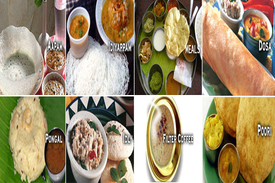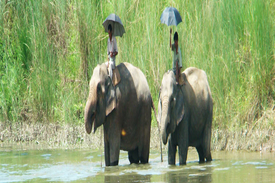Kuchipudi – The Divine Dance Drama
Kuchelepuri or Kuchelapuram was the earlier name of the village in the Krishna district of Andhra Pradesh. This village is 35 km. from Vijayawada. This form of Generic Dance drama was known as Yakshagana. It was Sihdhendra Yogi, a vaishnavite poet who gave shape to his visions in the 17th century, to establish this Kuchipudi style of Yakshagaana. He took the lead from the creation of Yaksha Gana from his guru Theerthanarayana, who had created the Sanskrit Kavyam , Krishna Leela Tarangini. Kuchipudi is a perfect balance between the three aspects of the art – Nritta , Nritya and Natya. Sidhendra Yogi Created Bhama- kalaapam, still considered as the irresistible Kavya of the Kuchipudi repertoire. Attracted by the aesthetic appeal of Kuchipudi, the then Nawab of Golconda, Abdul Hasan Tanishah issued a copper plate in 1675 A.D. granting the village Kuchipudi as an Agrahaarama to the families of Brahmins who pursued this art. These families were popularly called as the Bagavathalu of Kuchipudi. Earlier the female portions of the dances were impersonated by the males themselves as there were no female artiste.
Vedaantam Satyanarayana Sharma, a great Kuchipudi dancer, who performs the role of SatyaBhama even today, has set an excellent standard in that role. Lakshmi Narayan Sasthri (1886-1956) introduced new elements and dimensions to this art including solo dancing and training of female dancers in this dance format. Some famous exponents in modern Kuchipudi are Vempati Chinna Satyam, C.R. Acharyalu, and Dr. Nataraja Ramakrishna.
Bharatanatyam
This is one of the oldest form of dance in India performed in the Temples and in the Courts of Kings. Relating to its religious origin, it is almost similar to the dance format compiled by Sage Bharatha Muni in his famous Natya Sasthra. Bharatha Natyam was handed down as a living tradition from one generation to another as Devadasi System. Later, the Four brothers from Thanjavur of the early 19th century Chinnaiah, Ponniah, Sivanandam and Vadivel popularly called as the Thanjavur Quartet or Nattuvanars of Pandanallur, composed numerous varnams and kritis and contributed to the Development of Bharatanatyam and Carnatic Music. Highly talented artistes and the Male Gurus [Nattuvanars] were the sole repository of the art till 20th Century. By this time, due to lack of patronage and changed society modes, the Devadasi system started falling apart. Even though many contributed to the development of this art, it was the sincere and concentrated efforts of E.Krishnasamy Iyer and Rukmini Devi Arundale brought this Bharathanatyam Dance out of the boundaries of the Temples to the Public Stages, retaining the devotional charecterstics or features of the art. The school established for creating artistes to learn all types of classical dances was the brain child of Rukmini Devi Arundale. It was named KALAKSHETRA and it is located in Tiruvanmiyur, Chennai.
Today, Bharatha Natyam is one of the very popular and widely performed art practiced by Male and Female dancers all over India. UG and PG courses are offered in some of the major universities to develop the art of Bharathanatyam. Alarmee Valli, Bala Saraswathi, Mrinalini Sarabhai, Rukmini Arundale, Kamala Laxman, Padma Subrahmaniam and Chithra Visweswaran are some of the famous exponents of this art and Panthanalloor Meenakshi Sundaram Pillai, Panthanalloor Chokkalingam Pillai, Padmasree Vazhoor Ramayya Pillai and Adayar Laxman fits into the list of notable NATTUVANARS.
Carnatic Music
Indian classical music is categorized under two genres. They are Hindustani and Carnatic. Broadly Hindustani developed in the northern regions of the country, while Carnatic music is indigenous to the south of India. It is considered one of the oldest systems of music in the world. It is imbued with emotion and gives scope for the spirit of improvisation However it also contains a scientific approach. This is mainly due to the contributions of inspired artists as Purandara Dasa, who is known as the Father of Carnatic Music, and other scholars who codified the system of music and gave it a clear format as a medium of teaching, performing, prayer and therapy. The basis of Carnatic music is the system of ragas, which are melodic scales and talas or rhythmic cycles. There are seven rhythmic cycles and 72 fundamental ragas. All other ragas are considered to have stemmed from these. An elaborate scheme exists for identifying these scales, and they are known as the 72 Melakarta Ragas.
Carnatic music abounds in structured compositions in the different ragas. These are songs composed by great artists and handed down through generations to disciples. While the improvised elaboration of a raga varies from musician to musician, the structured portion is set. These compositions are extremely popular, with a strong accent on rhythm and lively melodic patterns. The three saint composers of the nineteenth century, Tyagaraja, Muthuswami Dikshitar and Shyama Shastri, have composed thousands of songs that remain favourites among musicians and audiences.
An important element of Carnatic music is its devotional content. The lyrics of the traditional compositions, whether mythological or social in nature, are set entirely against a devotional or philosophical background.
Folk Dance
Literature called as Iyal, Music called as Isai and Dance or Drama called as Nadagam are the three broad classifications of Art and Entertainment. The ancient Theru Koothu [Street Play] performed in almost all the villages, had all the three in its performance.
These dances are not choreographed but performed at social functions by people with or without training, generally vernacular, very often accompanied by traditional and locally or regionally practiced instrument[s] based music, with some distinguishing features. These dances were earlier meant for performance in its natural location or for regional festivals but not on stage. The performance of these dances are rather inherited by Tradition than Innovations. It must be accepted that these performances are arranged on stages these days with small modifications to suit that environment.
Dance Festivals
Natyanjali Dance Festival
The Natyanjali Dance Festival is held every year during the months of Feb-March and it is a five-day festival. This dance festival is one is a dedication to the universal dancer Lord Shiva who is known as Lord Nataraja. This festival is held in the city of Chidambaram in Tamil Nadu. The festival begins on the Maha Shivaratri, a day that is dedicated to the Lord Shiva and is held in the prakara of the Chidambaram temple.
This magnificent temple built thousands of years ago as a dedication to the Lord Nataraja forms a beautiful backdrop. The setting is truly divine with the gold-roofed temple and pillars adding splendour. They depict Lord Shiva in the 108 poses or mudras of Bharatnatyam, the classical dance of Tamil Nadu.
The Department of Tourism, Government of Tamil Nadu, The Ministry Of Tourism, Government of India and The Natyanjali Trust, Chidambaram jointly organize this festival or Utsav . This festival provides unique opportunities for dancers from around India to come and perform in front of an enormous crowd.
Mamallapuram Dance Festival
Mamallapuram Dance FestivalThe Mamallapuram Dance Festival is held every year during Dec-Jan in Mamallapuram, Tamil Nadu. This dance festival is organised by Department of Tourism, Govt. of Tamilnadu. Mamallapuram was once the ancient port of the Pallavas. Mamallapuram is the renowned and ancient 7th century centre for Pallava culture and art. Exponents of Bharatanatyam, Kuchipudi, Kathak, Odissi, Mohini Attam and Kathakali perform against this magnificent backdrop of the Pallava rock sculptures.
Mamallapuram was once the ancient port of the Pallavas. It now plays host to a vibrant festival of dance. Exponents of Bharata Natyam, Kuchipudi, Kathak and Kathakali perform against the magnificent backdrop of the Pallava rock sculptures.
Mamallapuram is a popular beach resort and a culture front, especially for the tourists, who come from the world over who love to imbibe and soak in the rich traditions. This town beach is full of ancient monuments, sculptures, caves, monolithic temples and beaches.
In Mamallapuram there is a Shore Temple that was built during the reign of Narsimha Varman of the Pallava dynasty in 8th century A.D. During the dance festival time the stones of temple begin to resonate with music and dance rhythms.
Thyagaraja Music Festival
Place: Thiruvaiyaru, Tamil Nadu
Time: January
Thiruvaiyaru is the pace where the great saint and musician Thyagaraja lived and attained samadhi. Here an eight-day music festival, the Thyagaraja Aradhana is held every year in January. This Carnatic Music festival attracts music lovers from all corners of the country. Thiruvaiyaru is situated 13kms from Thanjavur.
MADRAS MUSIC ACADEMY
The Music Academy is one of the earliest established organisations to promote serious study of classical music in South India. Established in 1928, it plays an important role in encouraging and promoting primarily Carnatic music It played a vital role in the revival of the Indian classical dance form Bharatnatyam in 1930s when the latter faced near extinction due to a negative connotation caused by conservative societal standards. In 1929, the Music Academy pioneered the concept of the December Music Festival, now a city-wide celebration of the classical arts, conducted by various organisations.




